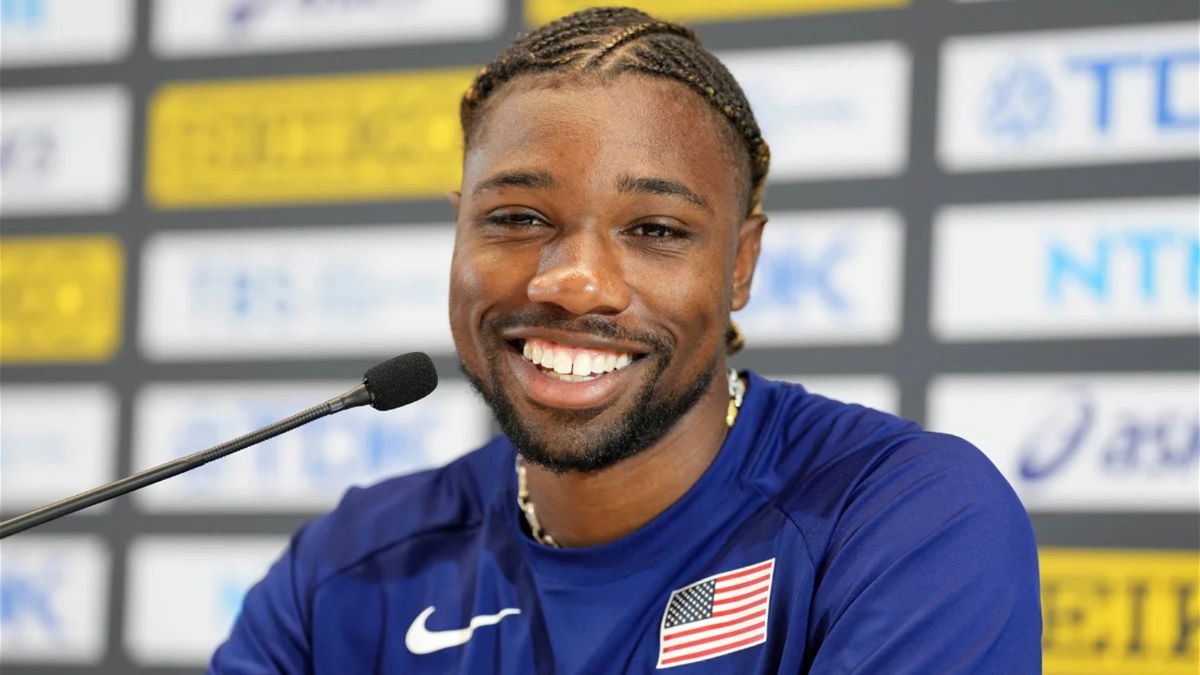

Track and field, a sport in rapid evolution, owes much of its growth to the legendary figures who accelerate its progress such as Michael Johnson, Alexis Ohanian, and more. However, outside of the Olympics, it often feels like a sport that only comes around once in a blue moon. One of the hurdles that track and field athletes constantly face is the glaring money disparity.
Watch What’s Trending Now!
Unlike athletes in major team sports, track and field competitors typically don’t receive regular salaries. Instead, they rely heavily on sponsorships and, if they’re lucky, prize money. This financial imbalance has been a long-standing Achilles’ heel for the sport. Recently, Noah Lyles took the baton on this issue in a YouTube podcast channel namely Track and Field News, shedding light on the financial hurdles that many track and field athletes must leap over.
Noah Lyles expressed his perspective on the perception of track and field from an outsider’s point of view. He emphasizes that while some may believe the sport needs saving, he disagrees with this notion. Instead, he believes that track and field doesn’t need saving but rather assistance and support to thrive and grow.
ADVERTISEMENT
He dismisses the idea that the sport is dying, comparing it to other sports like gymnastics or table tennis, which may have different levels of visibility or accessibility but are still actively pursued. He discussed the biggest change that came this year such as the benefits of initiatives like the Grand Slam track which was launched by Michael Johnson.

ADVERTISEMENT
Noah Lyles highlighted some of the positive aspects of the Grand Slam track initiative. As he puts it, “There are a lot of great points; having a salary for athletes is amazing. Having a place for athletes to go where they don’t have to worry about where their next paycheck is going to come from, if they’re going to get paid on time, how long it’s going to be—I mean, let’s take an athlete who might not have a contract. Let’s take, Trevor Bassett. ”
ADVERTISEMENT
Well, we all know Trevor Bassitt hasn’t had any sponsors for years which means he ain’t earned much or can say almost nothing. Yet he entered the 2024 Olympic Trials with his sights set on Paris. At the U.S. Track and Field Olympic Team Trials at Hayward Field, University of Oregon, Bassitt secured his spot in the 2024 Summer Olympics with a stellar third-place finish in the 400-meter hurdles, clocking 47.82 seconds. Despite competing without sponsorships, he made a statement by wearing unbranded gear from Bandit Running, focusing purely on his performance.

ADVERTISEMENT
However, Noah Lyles further stated about Bassit, “Trevor Bassett has made three championship teams but does not have a contract right now. It’s crazy to think about, but under the Grand Slam track, he might not need one. He’ll go in under contract and have a salary for a good four months, and that four months might be able to take care of his whole year, especially if he’s winning alongside that or placing in the top three. He’s making good money; he’s like, ‘Okay, now I have the ability to where I might not need a contract as much.’ So, it changes the game. “
Lyles further added about how the Grand Slam track format allows organizers to select athletes based purely on merit and performance, rather than being constrained by national quotas or contractual obligations. He suggests that such a system would create a clear distinction between athletes who are considered professional (likely based on their performance and rankings) and those who are not. This approach, according to Lyles, would emphasize competition based on merit rather than external factors like contractual obligations or nationality quotas. Now the question comes: how much will Grand Slam pay athletes?
ADVERTISEMENT
Is Grand Slam Track enough for athletes to earn?
Grand Slam Track will be launching in April 2025 with four events through the summer. Featuring a total annual prize pool of $12.6 million distributed across its series, GST will spotlight 48 elite athletes dubbed ‘GST Racers’. Chosen by the Grand Slam Track Racing Committee, these racers will compete in all four Slams annually. GST Racers will receive comprehensive support, including base compensation per Slam, full prize money eligibility, annual contracts, and access to exclusive athlete services and marketing opportunities.
Each Slam will award $12.6 million in prize money, with the winner of each event group taking home $100,000 and the eighth-place finisher earning $10,000. All prize money will be distributed based on final standings and performance across the events. Complementing the GST Racers, 48 GST Challengers will receive appearance fees to participate in individual Slams, selected based on recent performances and intriguing matchups. However, it’s far better than what athletes will win in the Paris Olympics.
ADVERTISEMENT
Even though World Athletics upped the ante with a substantial boost in prize money, offering Olympic gold medalists in track and field events a handsome $50,000 in Paris, ensuring that the cream of the crop will reap the rewards. Relay teams, too, will split the sum of a total of $50,000 but is it enough for athletes? What are your views on it?
Top Stories
Sources: John Harbaugh Wasn’t Fired, Left Ravens After Refusing Major Staff Changes

Bill Cowher’s Strong Message to Steelers on Firing Mike Tomlin After HC’s Blunt Playoff Message

Bengals’ Cam Taylor-Britt Sentenced to Jail: Everything We Know About Charges Against Him

Kyle Tucker Handed Blunt Reality Check as Blue Jays Shift Focus to Bolster Vladimir Guerrero Jr.

US Visa Rejections Put Major Track & Field Records at Risk at World Cross-Country Championships

Chiefs’ $58M News Complicates Travis Kelce’s Return As TE Gets 8-Figure Update

ADVERTISEMENT
ADVERTISEMENT
ADVERTISEMENT

